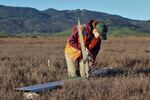
Tess Forstner (USGS) up the measuring tool as part of a study to determine the effect of sea level rise on coastal wetlands in the West.
U.S. Geological Survey
Over the next century, sea level rise is expected to wreak havoc on the U.S. coastlines – and a new analysis shows that the Northwest is not immune. Nearly all coastal wetlands in Oregon, Washington and California will be swamped at the highest predicted sea level change.
Sea level rise is a byproduct of climate change. It happens as the world’s oceans warm and physically expand. Melting glaciers and ice sheets are also contributing.
New research from the U.S. Geological Survey gives the first ever insight to how specific bays, marshes and harbors will fare.
“We wanted to collect data and build models at a smaller spatial scale. Really the scale of decision making,” said USGS ecologist Karen Thorne. “Like, ‘I’m a refuge manager and I want to know what’s going to happen to my wetlands’ or ‘I live in this town.’”
Coastal wetlands are important for wildlife and nurseries for our fisheries. They filter water and provide flood and erosion protection to coastal communities.
Thorne says under the lowest predictions of sea level rise – about five inches over the next century in the Northwest – wetlands will remain relatively stable.
But in higher scenarios that range anywhere from 2 to 6 feet, big changes are in store.
“You increase the water levels to a point that the plants start to die because they’re flooded too often. So when the plants start to die, you start to lose the ability to build or maintain the elevation of these wetlands,” Thorne said.
This starts off a negative feedback loop. What once was marsh becomes a mud flat.
The new models predict that many of the most profoundly affected wetlands in Oregon and Washington won’t be able migrate inland to higher elevations. Their path has been blocked by human development and the natural topography of our rocky coast.
Wetlands at Bandon Marsh, Coos Bay and Siletz Bay in Oregon are expected to disappear entirely if the higher projections for sea level rise hold. Port Susan, Nisqually and Skokomish in Washington will lose more than half their vegetation. Even at moderate rates of sea level rise, most of the coastal wetlands will look and function very differently.
But there are a few spots on Washington’s coast that are expected to weather this symptom of climate change better than elsewhere. Notably, wetlands in Willapa Bay and Grays Harbor in Washington are expected to survive.
“Thankfully, Willapa Bay is one of those estuaries that are in a better place than some of the others,” said Jackie Ferrier, manager of the Willapa National Wildlife Refuge.
“Because it’s so influenced by the river, there’s a large amount of sediment accretion that happens within the bay."
The sediment buildup continually raises the elevation of the wetlands and is projected to allow the marshes to keep pace with sea level rise.
Ferrier says the new information is helpful because of how localized it is. But she says the refuge will continue to rely on a range of predictive models to make decisions going forward.
The Willapa refuge is already taking actions to improve the quality of the coastal area. The refuge is in the middle of a massive habitat restoration project that is expanding the saltwater wetland footprint.
“I think our restoration puts us in an even better place because it does increase that resilience to sea level rise,” she said.
The results of the new research published Wednesday in the journal "Science Advances."
